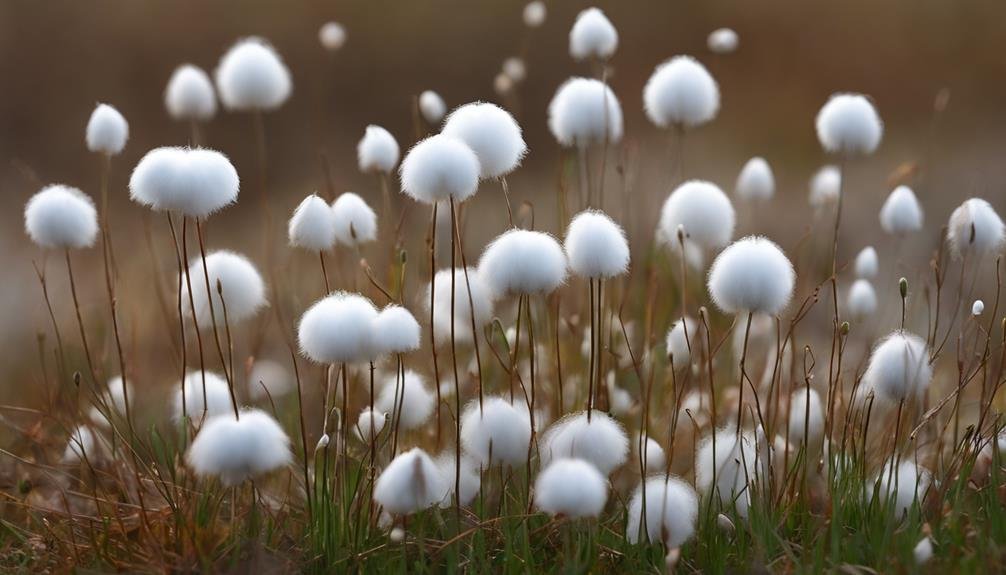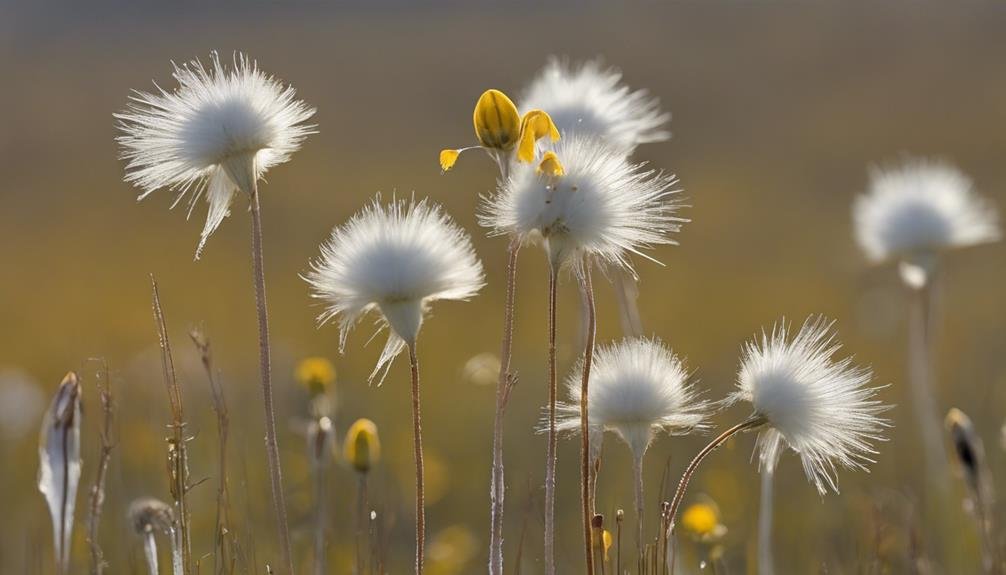What makes Cotton Grass (Eriophorum) such a unique species within its natural habitat? This query opens the door to understanding not just the biological characteristics of Cotton Grass, but also its ecological importance and the challenges it faces in today’s environment.
At the heart of northern marshes, Cotton Grass stands out as a captivating feature, with its delicate, cotton-like tufts swaying in the wind. This plant, a member of the Cyperaceae family, is finely tuned to survive and flourish in the demanding conditions of arctic, subarctic, and temperate zones. The fluffy fibers that crown its stems are not merely for show; they play a critical role in the plant’s seed dispersal mechanism, showcasing a fascinating aspect of natural adaptation.
Beyond its beauty and biological intrigue, Cotton Grass serves a vital function within its ecosystem. It acts as a support system for various pollinators and contributes significantly to the health and stability of wetland areas. However, despite its adaptability, Cotton Grass is not immune to the impacts of habitat degradation. The pressures of environmental change raise concerns about its ability to sustain its role in these fragile ecosystems.
To grasp the full picture, it is essential to consider both the resilience and vulnerabilities of Cotton Grass, examining how it interacts with its surroundings and the potential threats it faces. This overview sets the stage for a deeper exploration into the world of Cotton Grass, shedding light on its significance and the challenges it encounters in a changing climate.
Key Takeaways
Cotton grass, flourishing in wetland ecosystems within the Northern Hemisphere, plays a crucial role in these environments. Its perennial and tufted characteristics provide essential support to a wide range of pollinators and contribute significantly to the habitat’s structural diversity.
The issue of habitat degradation highlights the need for targeted conservation efforts. Understanding the ecological significance and geographical spread of cotton grass is key to developing strategies that aim to protect the biodiversity and functionality of wetland regions.
Key Takeaways:
- Cotton grass is a vital part of wetland ecosystems in the Northern Hemisphere.
- It supports pollinators and adds to the habitat’s structural diversity.
- Habitat degradation presents a significant challenge.
- Targeted conservation efforts are needed, based on an understanding of cotton grass’s roles and distribution.
Cottongrass Overview
Cottongrass: A Wetland Wonder
Eriophorum’s Habitat Preferences
Cottongrass, known scientifically as Eriophorum, is a beacon of health in wetland ecosystems with its distinctive fluffy tufts signaling ecological vibrancy. Thriving in acidic soils, this perennial sedge showcases white or tawny flowering tufts, marking its presence across North American wetlands. Its resilience and adaptability are evident in its dual reproductive strategies: seed dispersal and root expansion.
Diverse Species and Their Ecological Roles
The genus Eriophorum includes various species like Tussock, Slender, and Rough Cottongrass, each playing a key role in enhancing the biodiversity of wetlands in North America and Canada. These species support complex ecosystems, hosting a range of organisms and providing breeding grounds for birds, as well as nourishment for wildlife such as elk and geese.
Interdependence in Peaty Wetlands
In peaty wetlands, cottongrass coexists with other flora like Buckbean and Pitcher Plant, underscoring a rich biodiversity. This symbiotic relationship among different species highlights the critical need for wetland conservation. Protecting these habitats is paramount for maintaining ecological balance and supporting diverse life forms.
Tufted Perennial Form

Distinctive White and Tawny Tufts: A Wetland Marvel
Eriophorum, known for its white or tawny tufts, significantly influences the wetland ecosystems. This perennial sedge flourishes in the moist soils of northern areas, showcasing its beauty from late spring through early fall. Its solid, triangular stems, a unique structural adaptation, support the seed heads that set Cotton Grass apart in the wetland flora landscape.
The Role of Tufts in Eriophorum Diversity
The variation in tuft appearance among Eriophorum species, from copper-colored bristles to small white spikelets, plays a vital role in the ecosystem’s biodiversity. These tufts not only contribute to the visual aesthetics of the habitat but also have a practical function in the plant’s life cycle. The fluffy seed heads are designed for wind dispersal, aiding in the spread of Cotton Grass across vast wetland areas.
Cotton Grass: A Keystone in Wetland Ecology
Cotton Grass species provide critical breeding grounds for various bird species native to northern environments and offer foraging resources for wildlife such as elk, deer, and caribou. This highlights the essential role that Eriophorum‘s tufted perennial form plays in maintaining the food web and supporting the overall health and biodiversity of wetland habitats. Through its unique form and ecological contributions, Cotton Grass significantly enhances the richness of these ecosystems.
Wetland Global Presence

Cotton Grass: A Global Wetland Inhabitant
Widespread Distribution Across Hemispheres
Cotton grass, particularly the species Eriophorum angustifolium, showcases a remarkable ability to inhabit diverse wetland environments. Its presence is notable from the Subarctic and Arctic regions such as Alaska and Northern Europe, extending to temperate zones including New Mexico and Korea. This wide-ranging adaptability is a testament to the plant’s resilience and its knack for thriving in varied ecological settings.
Adaptability and Ecological Significance
Eriophorum has a preference for acidic soil and standing water, making it a key player in wetland ecosystems. Its global distribution across the Northern Hemisphere highlights not only the plant’s adaptability but also its ecological importance. Serving as a vital habitat and food source for numerous wildlife species, Eriophorum contributes significantly to the sustenance of wetland biodiversity. Its proliferation across Eurasia, North America, and the British Isles in such habitats underlines the plant’s crucial role in maintaining ecological balance and supporting the intricate web of life in wetlands.
A Guardian of Wetland Biodiversity
The widespread occurrence of cotton grass across diverse climates and regions illustrates its intrinsic value in upholding ecological equilibrium. Eriophorum stands as a guardian of wetland biodiversity, emphasizing the plant’s fundamental contribution to these unique ecosystems. Through its global presence, cotton grass not only showcases its environmental resilience but also highlights the importance of preserving such adaptable species for the health of our planet’s wetlands.
Pollinator Support Role

Cotton Grass’s Contribution to Pollinator Nutrition
Nourishing Pollinators with Nectar and Pollen:
The blossoms of Cotton Grass stand out as a bountiful supply of nectar and pollen. These components are indispensable diets for bees, butterflies, and flies, ensuring their survival and health.
Promoting Genetic Diversity through Pollination:
The visitation of pollinators to Cotton Grass isn’t a mere chance encounter. It’s a symbiotic relationship that aids in the plant’s reproduction. Pollinators carry pollen from one flower to another, facilitating cross-pollination. This process is vital for the genetic variation and resilience of Cotton Grass populations.
Magnet for Bees:
Among various pollinators, bees have a special affinity for Cotton Grass. The plant’s nectar is a rich resource for these insects, and in return, bees play a pivotal role in the pollination of Cotton Grass, ensuring the continuation of this plant species.
Upholding Ecosystem Health:
The dynamic between Cotton Grass and its pollinators exemplifies the intricate relationships within ecosystems. This interaction not only aids in the propagation of Cotton Grass but also bolsters the health and diversity of the ecosystem, highlighting the importance of preserving such mutual relationships for ecological balance.
Habitat Degradation Impact

Human Impact on Wetland Ecosystems
Human endeavors such as drainage, agriculture, and urban development have a profound effect on the natural habitats of species such as Eriophorum angustifolium, commonly known as cotton grass. These activities carve into the very heart of wetland ecosystems, shrinking the available space for cotton grass to thrive. The reduction in their natural habitats not only endangers these species but also diminishes the overall biodiversity and disrupts the ecological balance vital for the health of these ecosystems. The degradation of peatlands and bogs, which are critical environments for cotton grass, showcases the severe impact human actions can have on these delicate areas.
Climate Change: An Aggravating Factor
The situation is further complicated by climate change. With the planet experiencing rising temperatures, shifts in precipitation patterns, and more frequent extreme weather events, the already vulnerable wetland habitats face additional threats. These climatic changes further strain the delicate balance required for cotton grass and similar species to survive, emphasizing the need for immediate and effective conservation measures.
The Path to Conservation
To counteract the adverse effects of habitat degradation and climate change, focused conservation initiatives are crucial. Safeguarding wetland ecosystems not only helps preserve the unique ecological roles and cultural significance of cotton grass but also ensures the continued biodiversity and ecological resilience of these areas. Effective conservation strategies are key to protecting these environments and the myriad of life forms they sustain, amidst the ongoing challenges posed by human activity and climate change.
Frequently Asked Questions
Can You Eat Cotton Grass?
Q: Can you eat cotton grass?
A: Yes, you can eat cotton grass. It is edible and offers nutritional value, making it significant in certain cultures and useful for survival. However, it is important to know how to prepare it properly and be aware of any potential allergies before consuming it.
Is Cotton Grass a Perennial?
Is Cotton Grass a Perennial Plant?
Yes, Cotton Grass is a perennial plant. It exhibits strong growth habits and is capable of adapting to a wide range of climates. It naturally occurs in environments from arctic to temperate zones and reproduces both through its seeds and via root spreading, ensuring its presence year after year.
What Is the Common Name for Cotton Grass?
Q: What is the common name for the species that thrives in wet habitats and blooms in spring?
A: The common name for this species is Cotton Grass. It is found in wet habitats, blooms during the spring season, and has a widespread distribution. The conservation status of Cotton Grass varies globally, and it requires specific conditions for successful growth.
What Are the Benefits of Cotton Grass?
Q: What are the key benefits of cotton grass?
A: Cotton grass plays a significant role in habitat restoration, aiding in the recovery of damaged ecosystems. It is effective in carbon sequestration, capturing carbon dioxide from the atmosphere, which helps combat climate change. This plant contributes to erosion control by stabilizing soil with its root system. It provides support to wildlife by offering habitat and food resources. Cotton grass is used for decorative purposes due to its unique appearance. Lastly, it contributes to the health of wetland ecology, supporting a diverse range of plant and animal life, which is vital for maintaining biodiversity and environmental health.
How Does Moss Campion Compare to Cotton Grass in Its Adaptation to Harsh Environments?
Moss campion and cotton grass both thrive in harsh, alpine environments, but they have different survival strategies. Moss campion, with its cushion-like shape, retains heat and minimizes water loss, traits highlighted in silene acaulis characteristics. In contrast, cotton grass has long, fibrous roots for stabilizing in wet, windy habitats.
What Are the Key Differences Between Polar Grass and Cotton Grass in Their Growth Habitats?
Polar grass and cotton grass differ primarily in their habitats. Polar grass species are typically found in tundra environments, thriving in cold, dry conditions with low nutrient availability. In contrast, cotton grass often grows in wet, boggy areas, requiring more moisture and higher organic content in the soil for optimal growth.
Conclusion
Cotton grass, thriving in wetland ecosystems across the Northern Hemisphere, stands as a vital component of these habitats. Its tufted perennial nature not only supports a variety of pollinators but also enhances the structural complexity of its environment.
The challenges posed by habitat degradation underscore the importance of focused conservation efforts. A deep understanding of cotton grass’s ecological roles and distribution is pivotal for developing effective strategies to counter these threats, aiming to safeguard the diverse life and functionality of wetland areas.


